Last summer, when Man City were chasing a striker, it turned out there was no one, especially Harry Kane was unable to leave Tottenham Hotspur at that time. Instead, City very quickly snapped up Jack Grealish from Aston Villa, who had very consistent and good performances in the past few seasons.
Time flew and seven months later, Grealish has not shone and scored 20+ goals – he is lacking goals and missed some chances this season. Hence, it was a small wonder to see the pundits and ex-players calling out his name to question his contribution. For example, Rodney Marsh, the big signing of City in the 1970s criticized Grealish as a “periphery” to the squad while Alan Shearer, also said, “Everything Grealish did was safe and simple. It looked as if he was scared to lose possession and take a gamble.” It sounds like Grealish has been a failure and has a bad season at City, is that the truth? Apparently, yes, but if we dig deep, NO!
Data analysis
In the first part of the scout report, we were using data to examine the performances of Grealish in the Premier League so far, by comparing his number with other players in the same league.
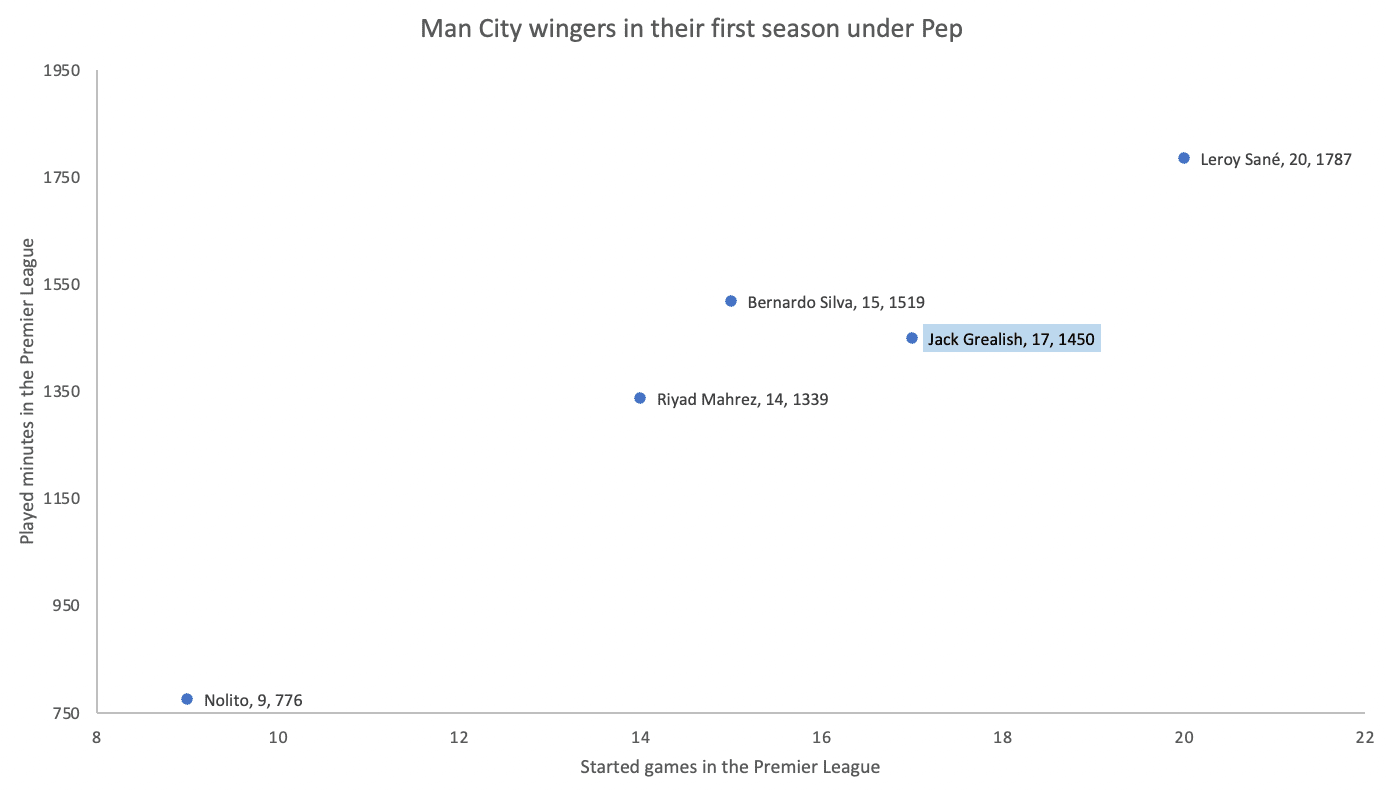
Firstly, we compared the playing minutes and games started of the new winger signings at City since Pep Guardiola has arrived. Everyone knew that Pep was a demanding coach, and he never care about the price tag, what determined the playing time of the players were their attitude, performance during the training and on the pitch. Hence, it would be a fair reflection to see how Grealish has been doing in his first season compared with the others.
We included Riyad Mahrez, Bernardo Silva, Nolito, and Leroy Sané in the chart. Grealish, as a new signing, already had 17 starts with 1450 minutes in total for the champion, the number of games started was only behind Sané’s first season, while there were nine games ahead this season, there was a chance to surpass the record. Although B. Silva had 69 more minutes on the pitch than Grealish in his first season, the Portugal international actually had 20 appearances coming in as a substitute, while Grealish was adversely affected by injuries on several occasions, he was comparable if not better than B. Silva’s first season.
And, see how good Riyad Mahrez has been in these seasons, he only had 14 starts and 1339 mins in 2018/19, and that reflects the wingers joining Pep’s City needed time to adapt, everyone has to go through that process.
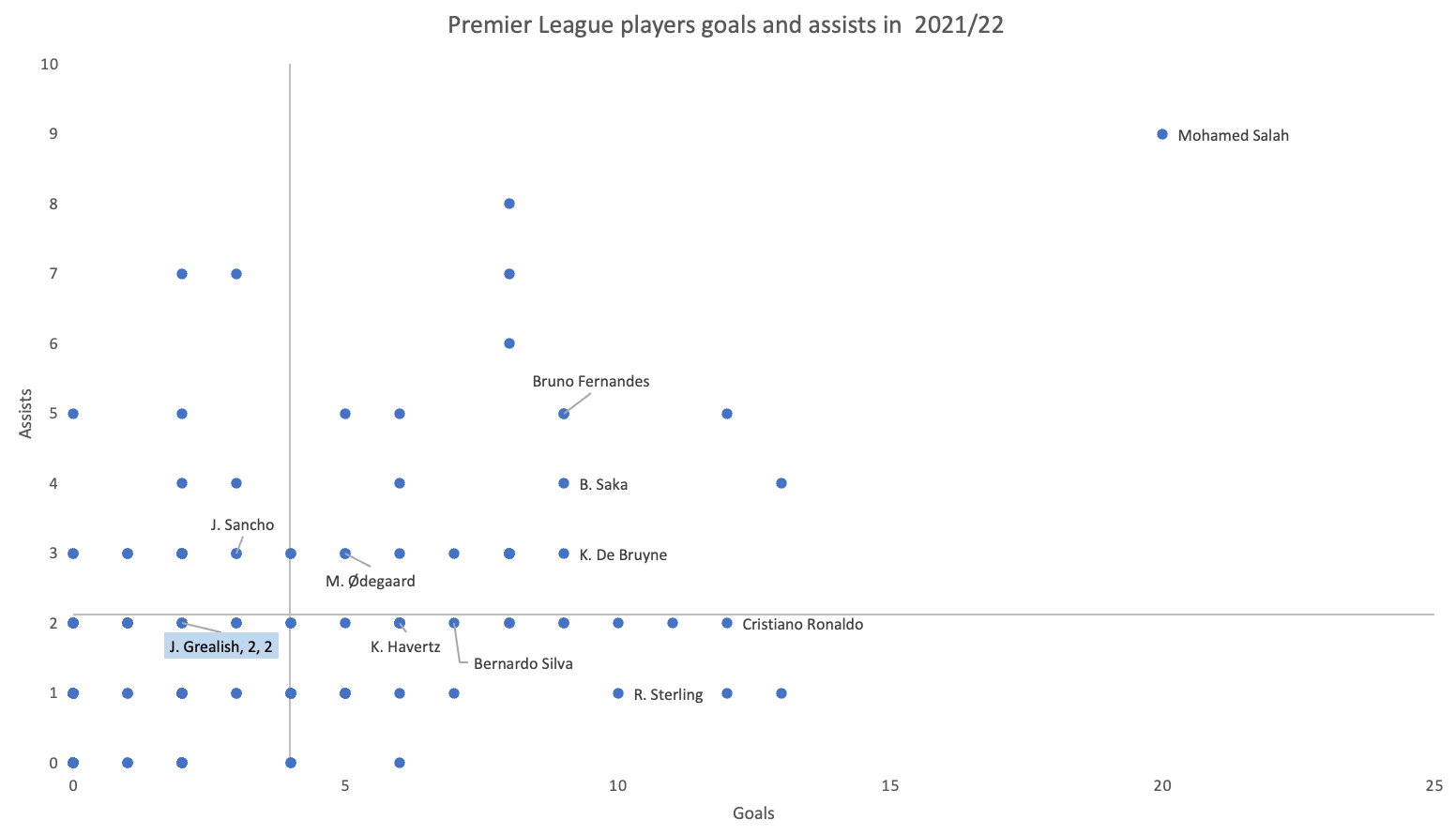
Back to the stats of this season, one of the main criticisms of Grealish, as reflected in the above table, was his goals and assists were lacking so far. The former Villa captain only had two goals and two assists in the Premier League League, which was very unimpressive. The rest of the City stars, Raheem Sterling (10G 1A), B. Silva (7G 2 A), Kevin De Bruyne (9G 3A), and Riyad Mahrez (10G 4A), all had better numbers in this perspective.
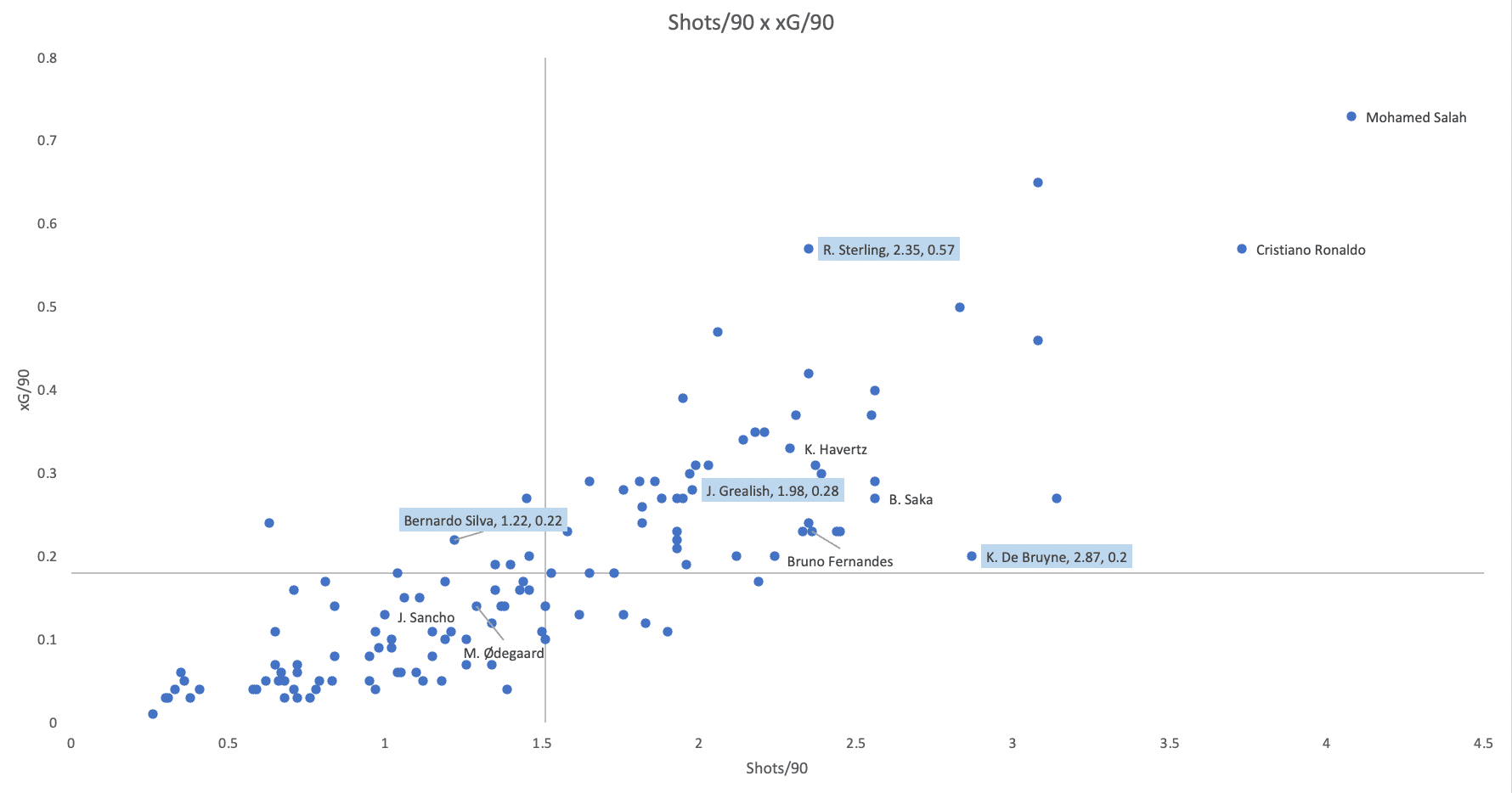
While looking at the Shots/90 and xG/90, Grealish was better than his goals and assists. Sterling was doing a great job with 2.35 shots and 0.57 xG/90, which was high compared to not only his teammates but also the others in the league. Grealish was also on the top right quadrant, which means he was higher than the average in both metrics. Although Grealish’s 0.28 xG/90 from 1.98 shots/90 was not the best, he was actually more able to shoot from goal-scoring positions, compared to De Bruyne, as Grealish’s shots/90 was lower than De Bruyne’s, which means Grealish required fewer shots to obtain a higher xG.
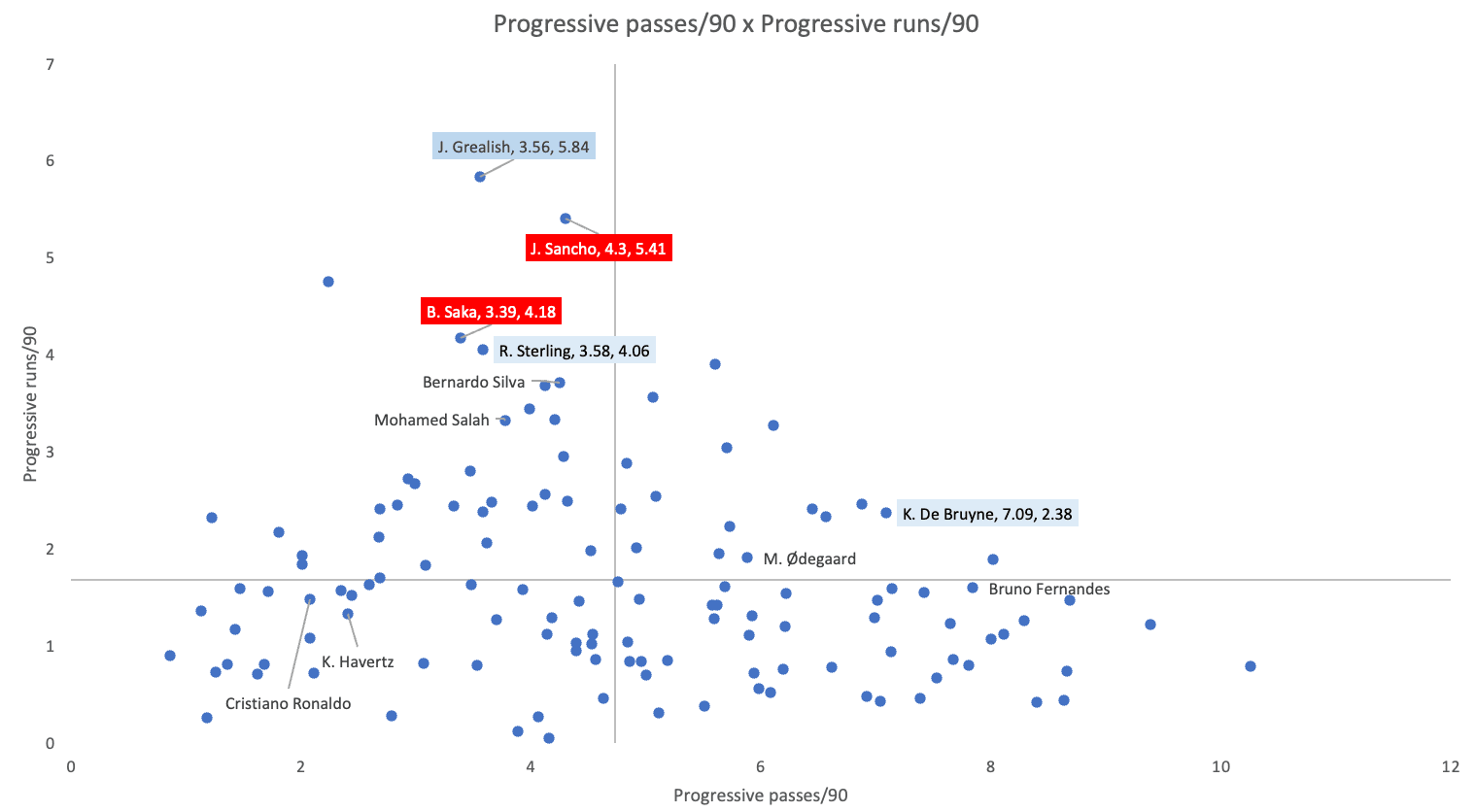
And if we considered more metrics, Grealish’s performance, was actually very good, arguably the best in the league in some aspects. He has a very important role in helping City’s ball progression, as we have shown in the above scatter plot. Grealish contributed 3.56 progressive passes/90, which was not very impressive, but he also offered 5.84 progressive runs/90, which was far higher than any other players in the Premier League!
Compared to Sterling and De Bruyne, Grealish had far more progressive runs and that was something special in the City team with so many talents.
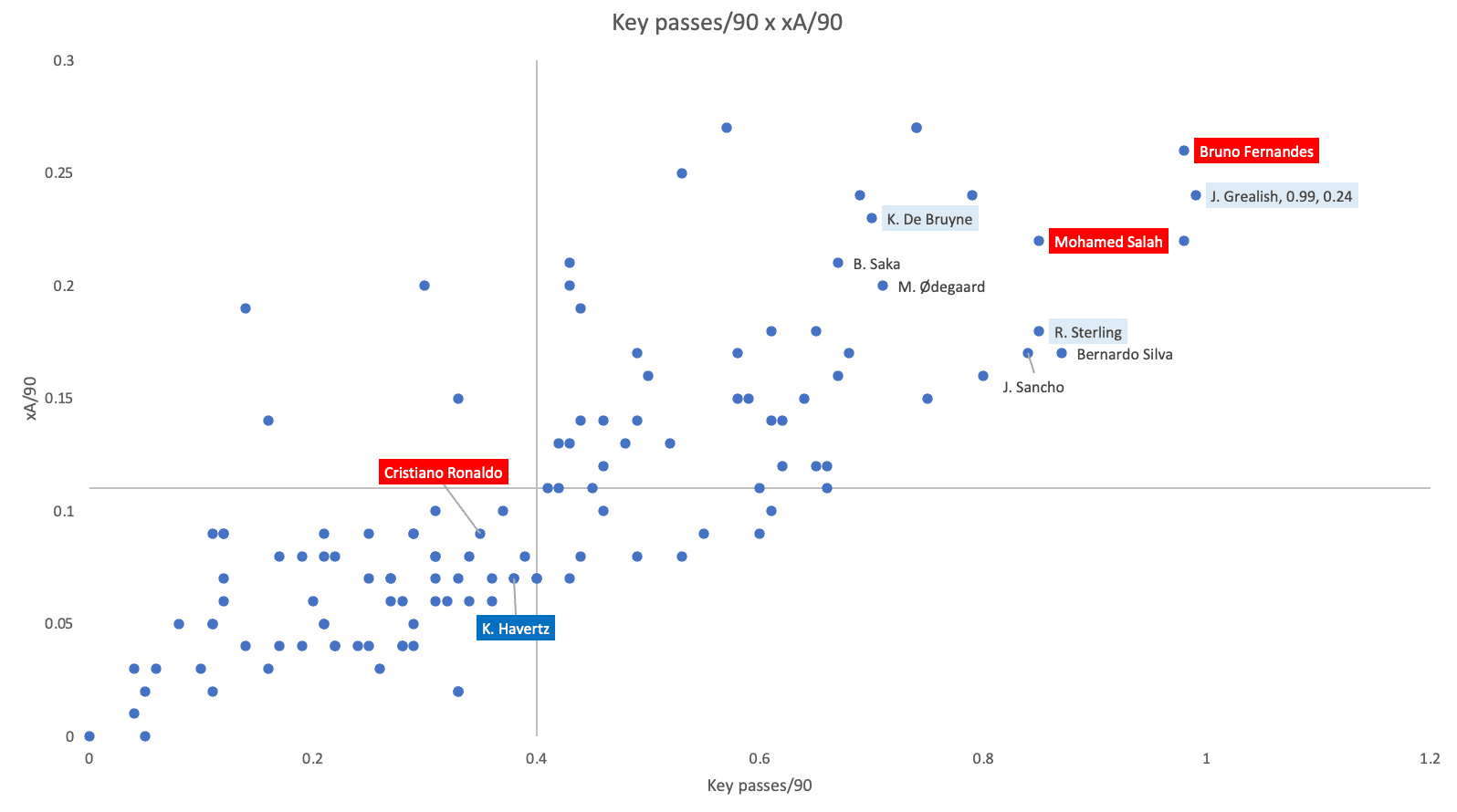
In terms of chance creation, by numbers, Grealish was in another class as one of the best in the league. He has 0.99 key passes/90, alongside with 0.24 xA/90, although he was lower than the likes of Bruno Fernandes in the latter metrics, however, he sliced more key passes than any other players on a 90-min basis. It suggests Grealish should not be seen as a scorer, and maybe more a part of the team and as a creator.
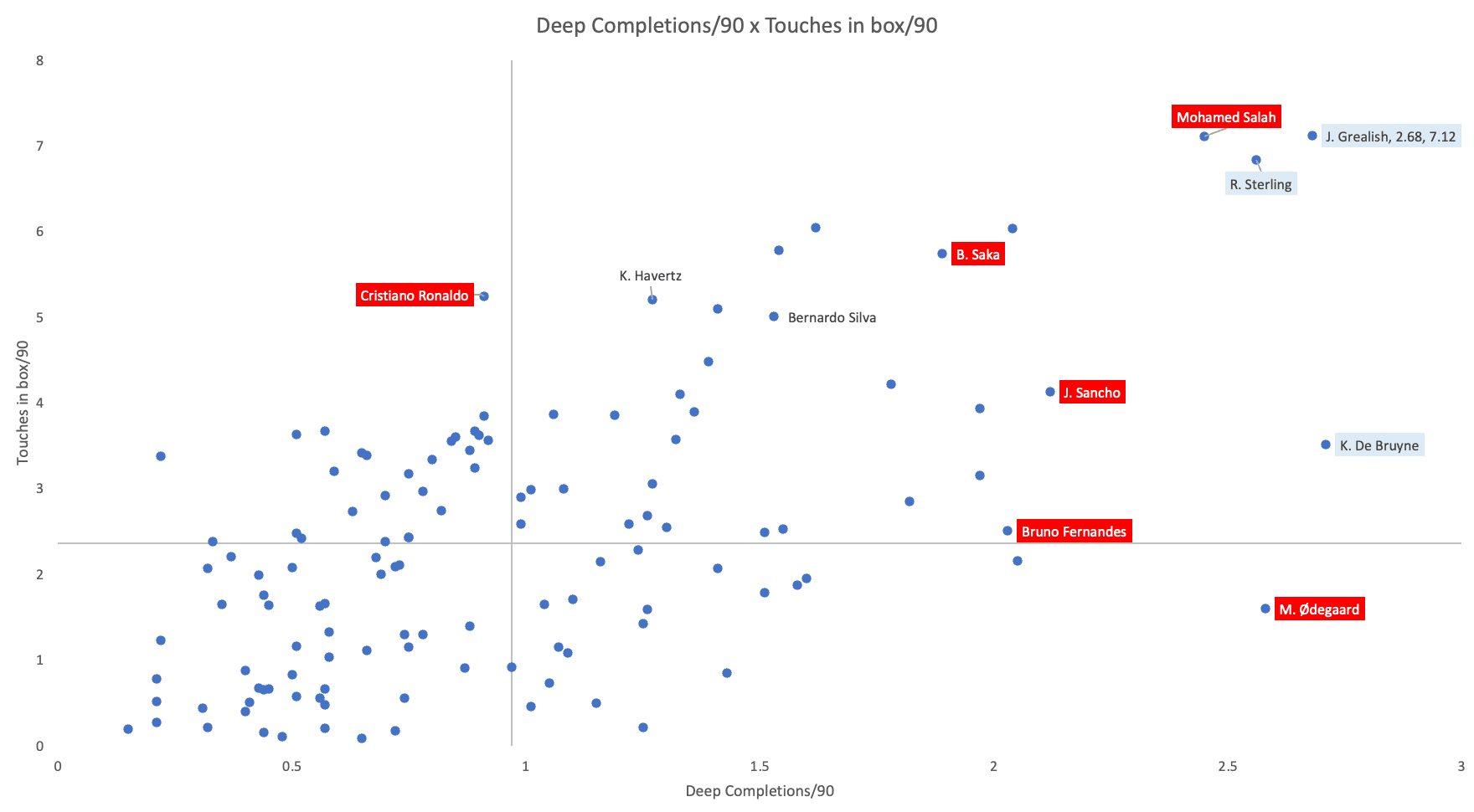
We could also measure a player’s threat to goal with numbers, and Grealish was outstanding as well. In terms of deep completions/90, Grealish’s 2.68 was the second in the league, only ranked lower than his fellow, De Bruyne. Meanwhile, he also had 7.12 touches in the box/90, it shows he had a good presence in areas close to the opposition goal as well.
According to the chart, Grealish, in fact, is the most all-rounded player in both metrics. Mohamed Salah was good at touches in the box while De Bruyne was good at deep completions, but none of them were good in both as Grealish did. While the likes of Bukayo Saka and Martin Ødegaard received compliments because of their good performance, they were not reaching Grealish’s level in these regards.
Tactical analysis – City with possession
The numbers were not lying, tactically, Grealish was also very important to the team. He was deployed as a left-winger at the beginning of the season, although he still played in that position now, he was also a “false-9” under Pep. In his first season, he already very quickly picked up the key concepts and functioned very well in this role.
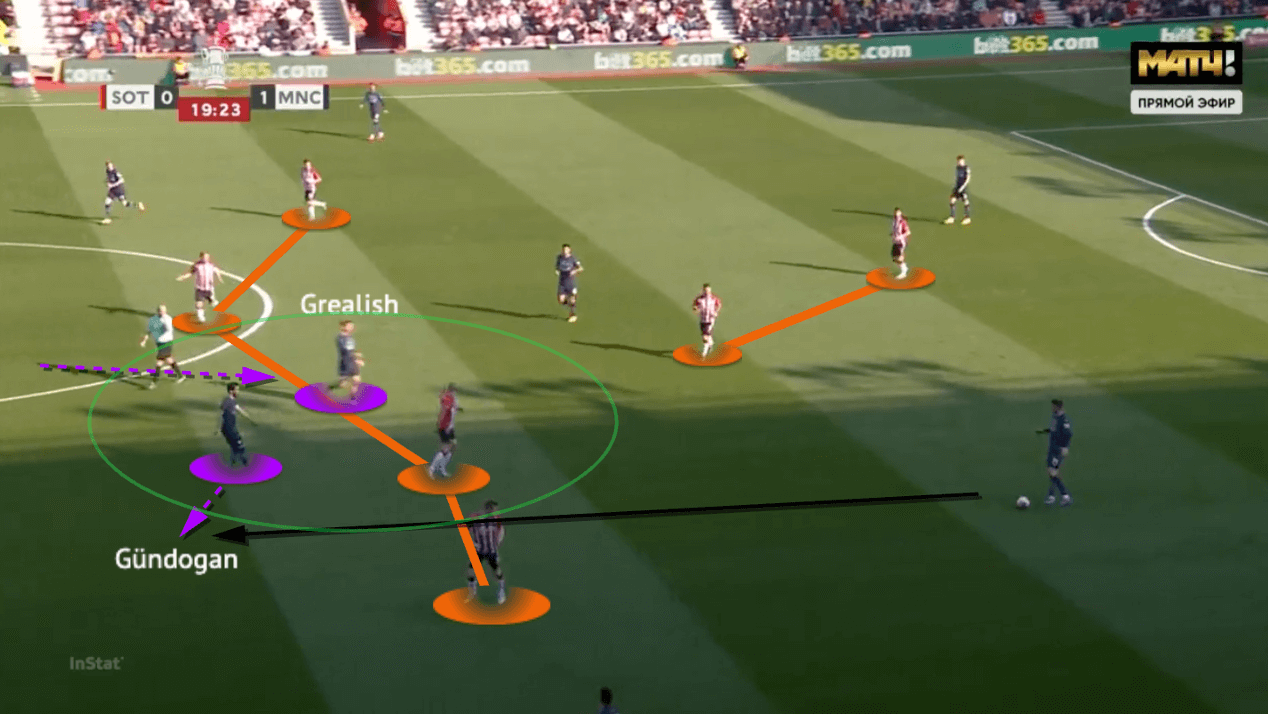
For example, in the above image, where City were constructing the attack against Southampton’s 4-4-2, they added Grealish as the extra man to create a 3v2 overload on the midfielders. Grealish was good at timing his drop so he did not close the space prematurely. On the contrary, he suddenly showed up in the centre and fixed the opposition 6’s attention, hence, creating rooms for İlkay Gündoğan to receive behind the midfield, so City could break the lines with a simple vertical pass in half-spaces.
Without touching the ball in the process, Grealish was still contributing.
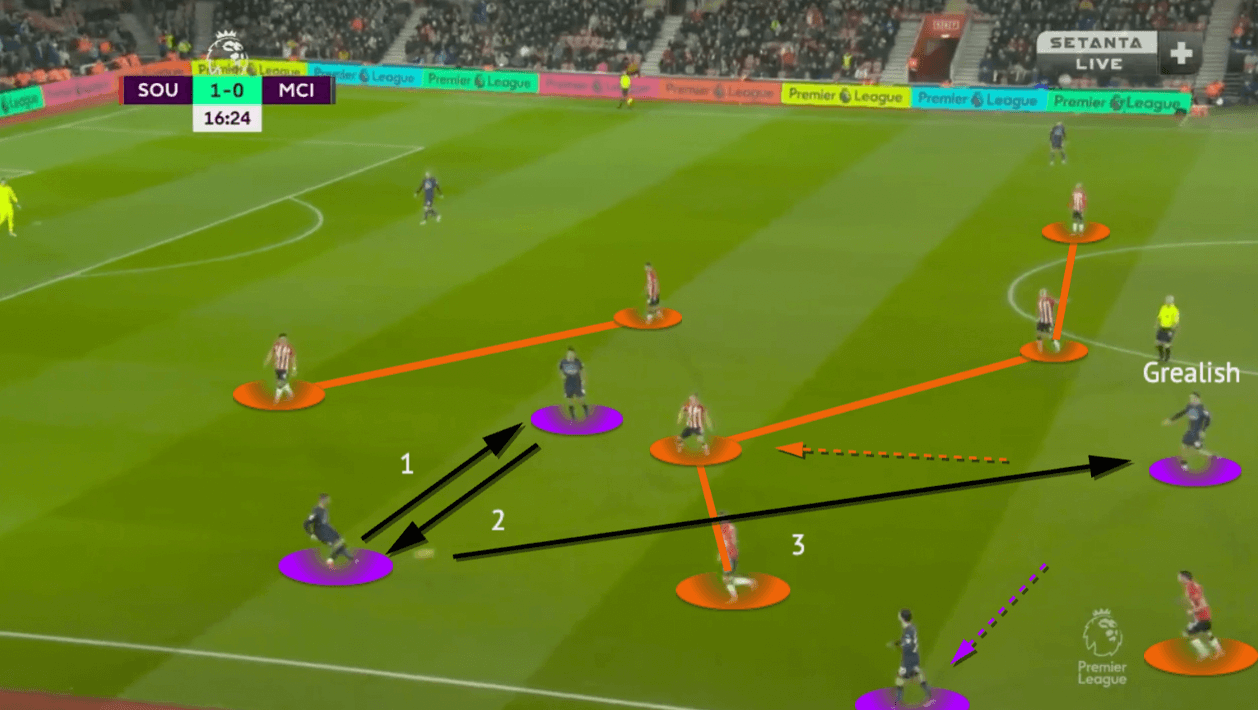
As the false-9, Grealish is very good at collaborating with teammates and receiving in the pocket of spaces in the centre. Here, in the Premier League game against Southampton, we can see Rodrigo Hernández dragged the opposition 6 out, while B. Silva was providing the width on the right side, Grealish very cleverly dropped into spaces vacated by teammates to open an option for Kyle Walker.
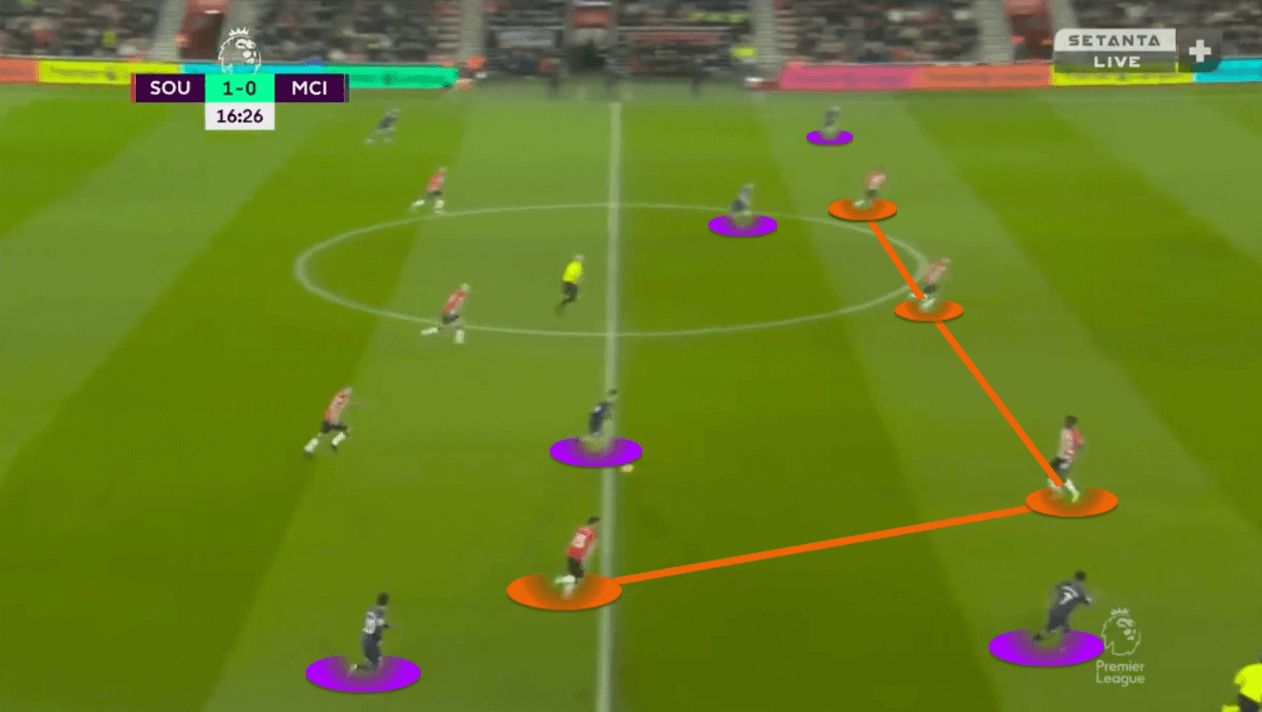
Another valuable quality of Grealish was his ability to turn, he has very good technical skills, which allowed him to turn in tight spaces in the centre. That was something he and Foden can compensate for in each other to create optimal game tactics, Pep could choose a right-footed player or left-footed player as a false-9 depending on the circumstances.
And how, because of Grealish’s clever turn, now City could go all the way with five players sprinting towards the four-man backline of Southampton.
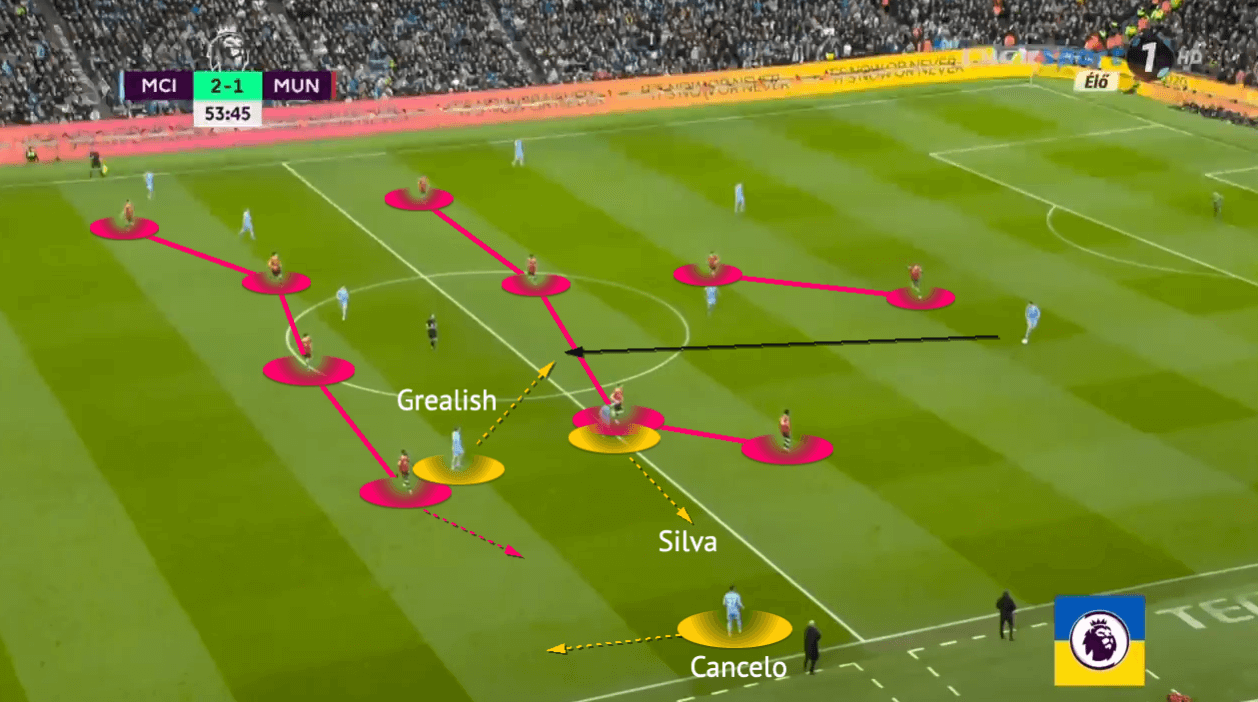
As suggested by the progressive runs/90, Grealish was very good at carrying the ball forward. In the Manchester derby, there was an occasion which Grealish impressed everyone, in that game, he started as a left-winger.
As usual, Grealish was very good at making his moves by taking his teammates’ moves as references. Here, he knew Joāo Cancelo was going high and wide, attracting the United right-back, while B. Silva was moving laterally outside to drag away Scott McTominay. Then, Grealish smartly sensed this as an opportunity to dismark Aaron Wan-Bissaka and there were spaces vacated by B. Silva, he showed up in the midfield to open a vertical passing option for Aymeric Laporte.
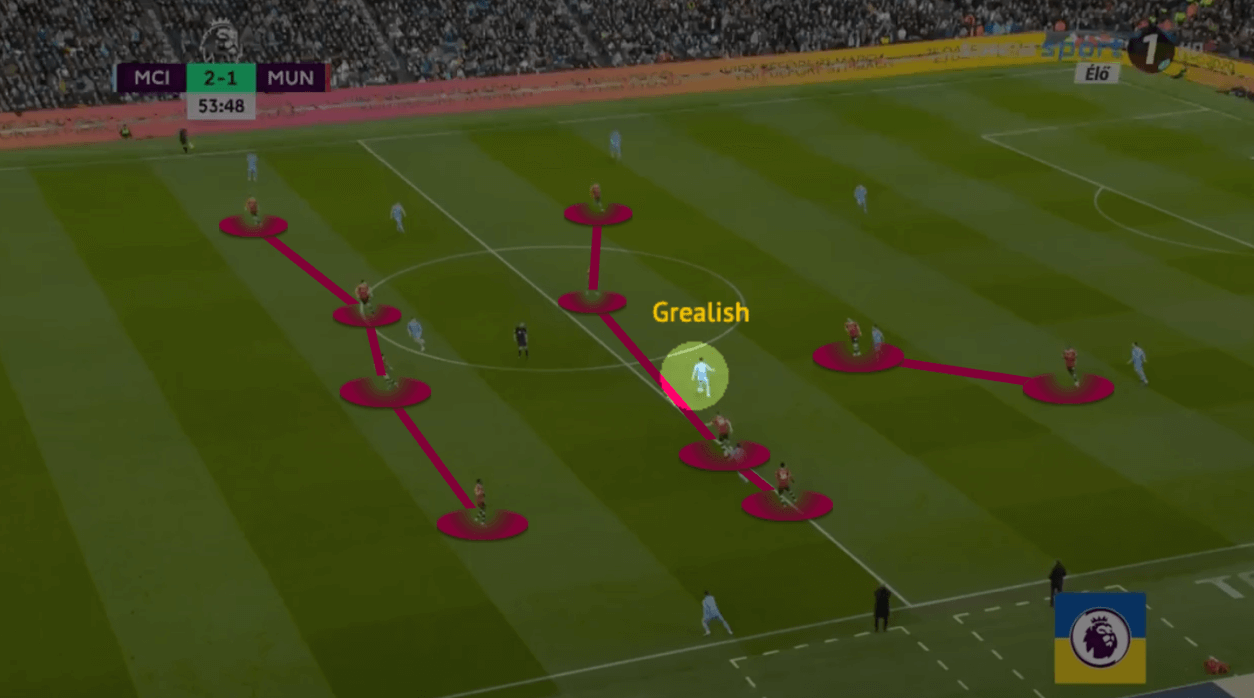
Then, in the above screenshot, we can know why Grealish was good at turning in the midfield. He did the basics very well, when the ball arrived, he used his far foot to control the ball, so his body was opened up for further actions.
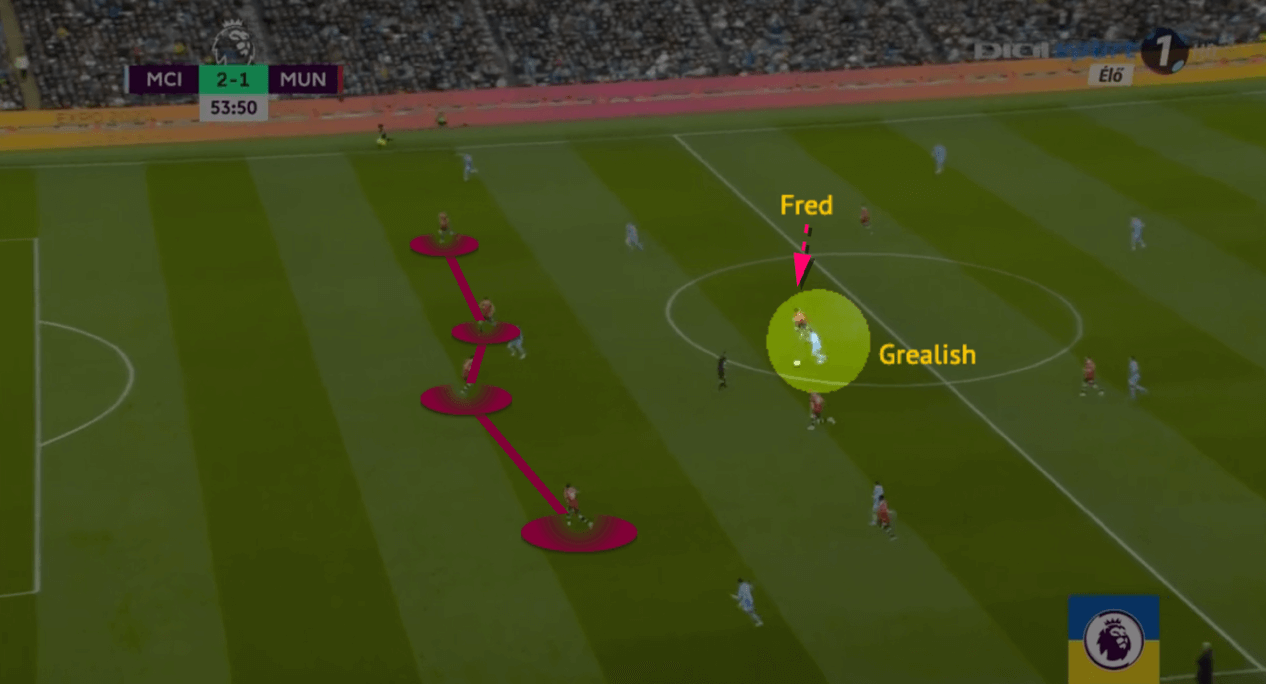
Then, the whole sequence was about how he managed to use his techniques to escape from the opponent, despite Grealish was never a quick player. In the next screenshot above, Fred was running back to press Grealish from the left side.
Grealish was very clever because his second contact with the ball was not heavy – that was a decoy touch to lure Fred into the central circle.
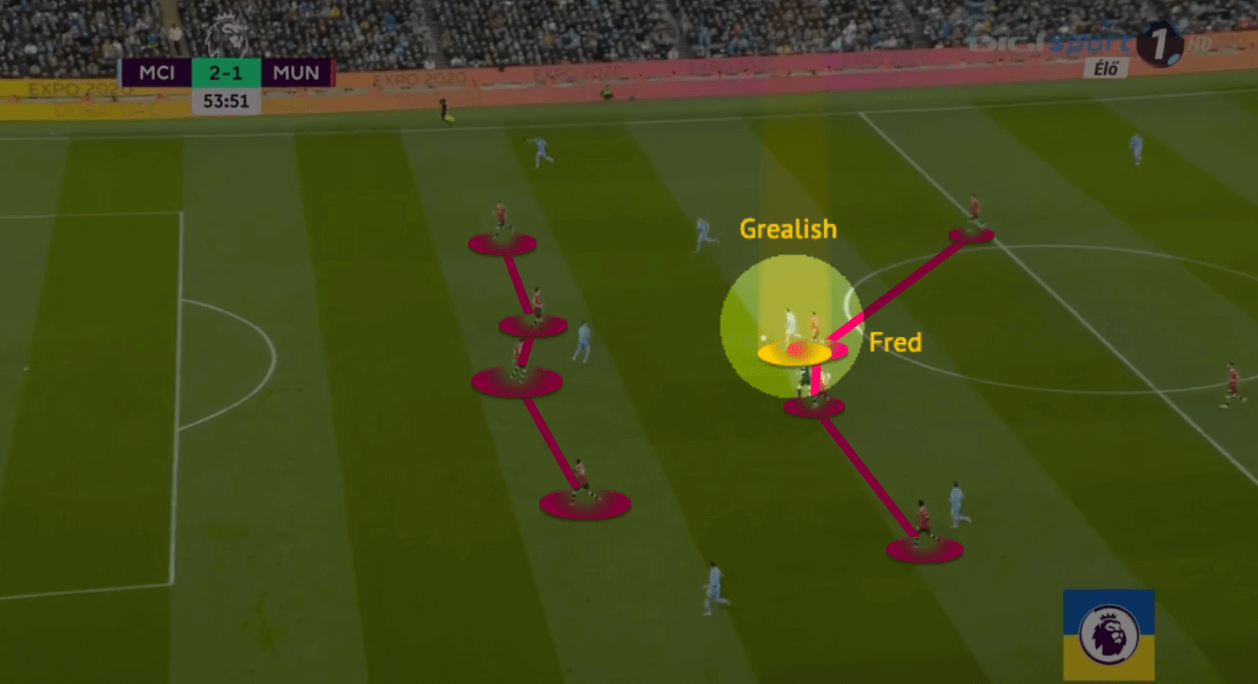
When Grealish saw Fred almost arrived, he made another touch, which was relatively heavy so he could roll the ball to his front. This heavy touch was also very appropriate because that helped him to escape from Fred. In the above picture, Grealish was already in front of Fred, blocking the opponent and the ball with his body, Fred had no way to stop him unless pulling him down. In reality, Fred just let Grealish run towards the defence and that became a favourable condition for a City attack.
As we explained through these examples, Grealish was a technically gifted player who have good control of his body and pace, he judged the timing very well to execute the actions, and those progressive carries made him a good false-9 at City.
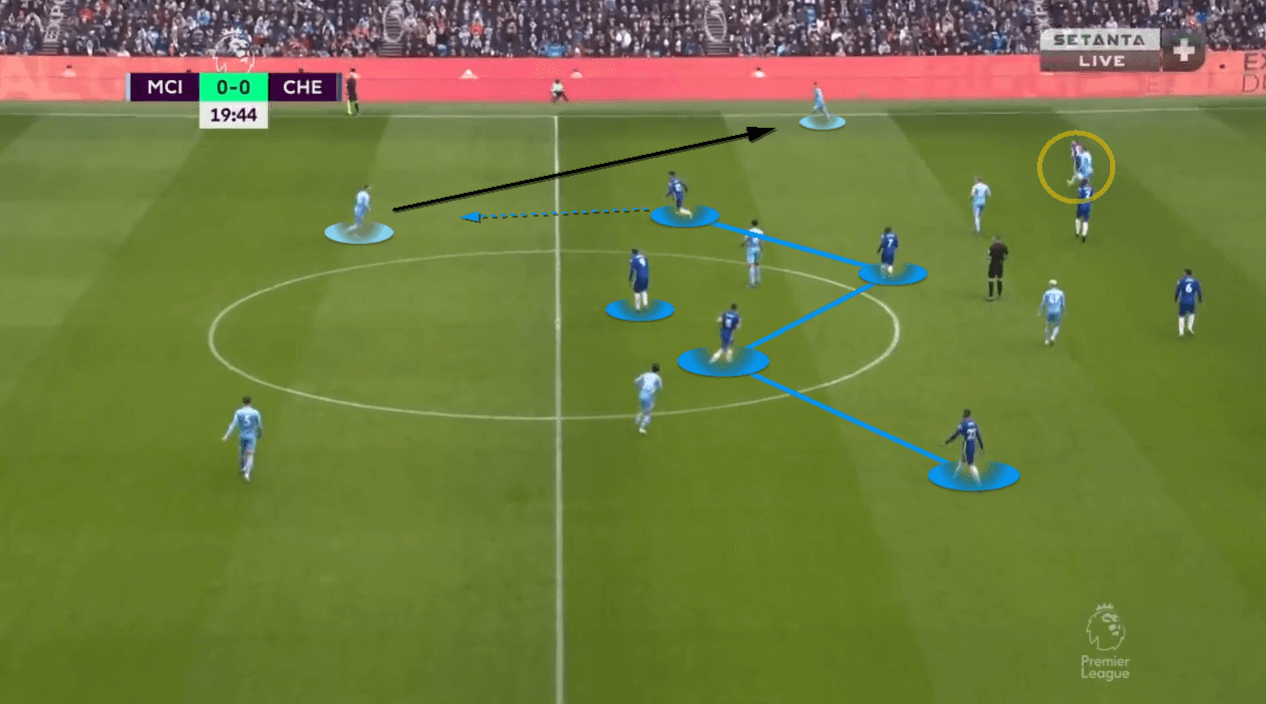
In addition, Grealish was very unselfish. At Villa, he had a lot of freedom to play around; at City, he was required to be more disciplined with his position, it was not moving around, instead, being at the right position at the right moment
As a left-winger, Grealish did a very good job to open spaces for the full-back. He always moved to move the opposition full-back. In the above screenshot, Grealish occupied the Chelsea wing-back inside and ended up in the half-space, so Cancelo could receive without the opposition pressing to further develop the attack.
Tactical analysis – City without possession
Without possession, Grealish also grasped the keys required by Pep, especially after the RB Leipzig game. In this section of the analysis, we will explain his defensive actions and how correct were these to the team.
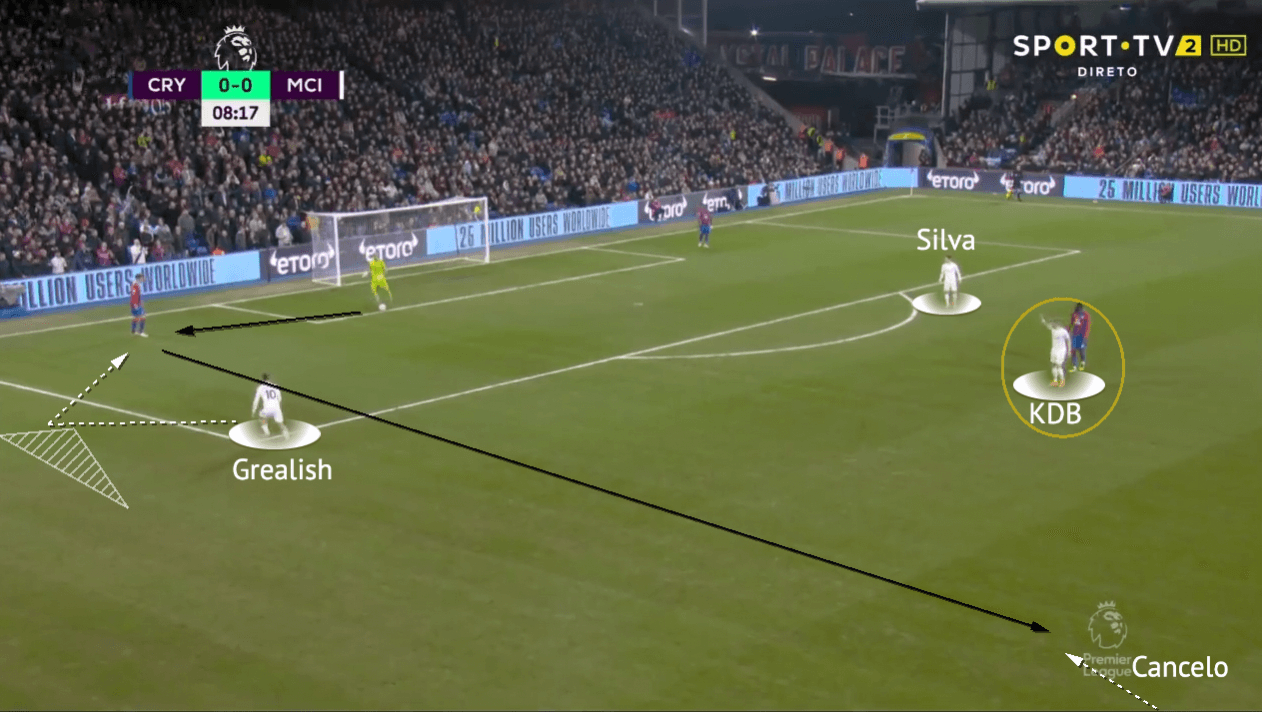
Firstly, Grealish already did the curve runs well for City, which was the foundation of Pep’s pressing system. By doing so, they wanted to guide the opponent into a specific direction so the defenders could see and come out to press in the midfield.
In this example against Crystal Palace, Grealish curved and pressed from the outside, so the centre-back was lured to play a vertical pass in to the half-spaces, where Cancelo could read in advance and close the space before the opponent arrived.
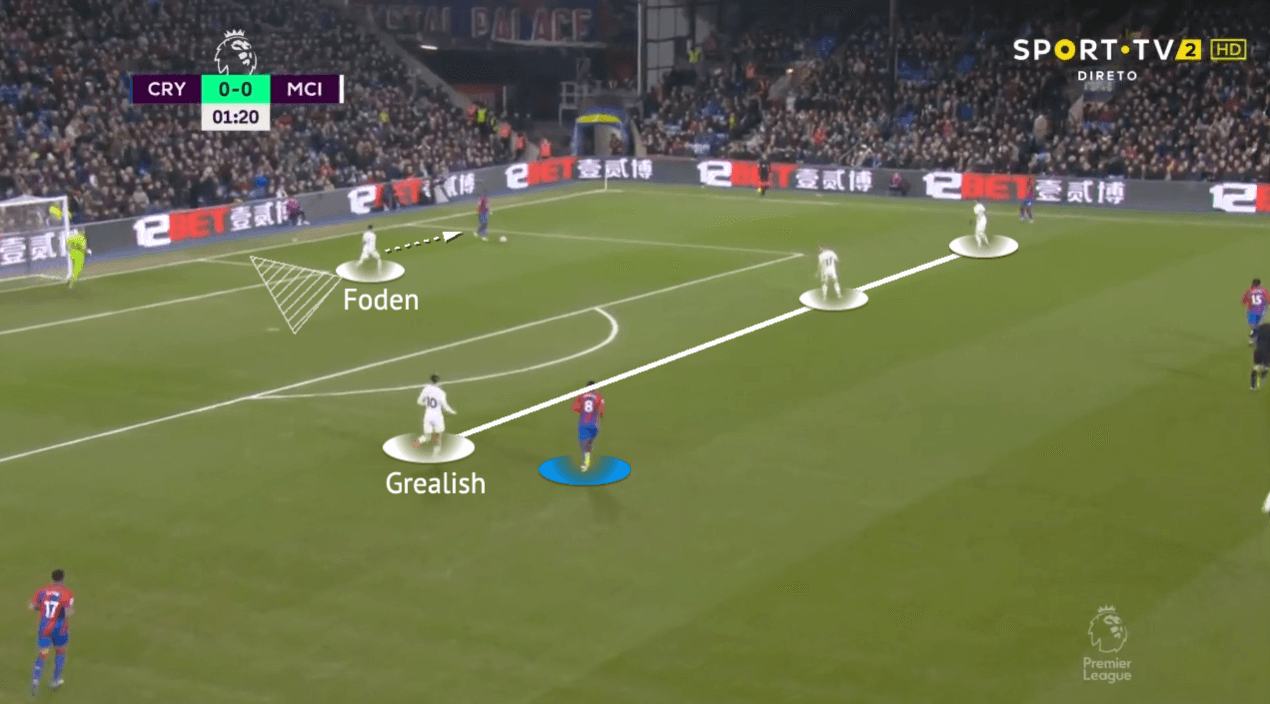
In terms of defensive positioning, Grealish was very disciplined as well, and he also quickly understood what the manager required. In City’s 4-2-3-1 pressing system, on most occasions this season, the far side must come in to balance the shape. Hence, in this example against Palace above, when the opponents were constructing the attack on the other side, Grealish was in the centre to mark a midfielder, making the City shape more compact.
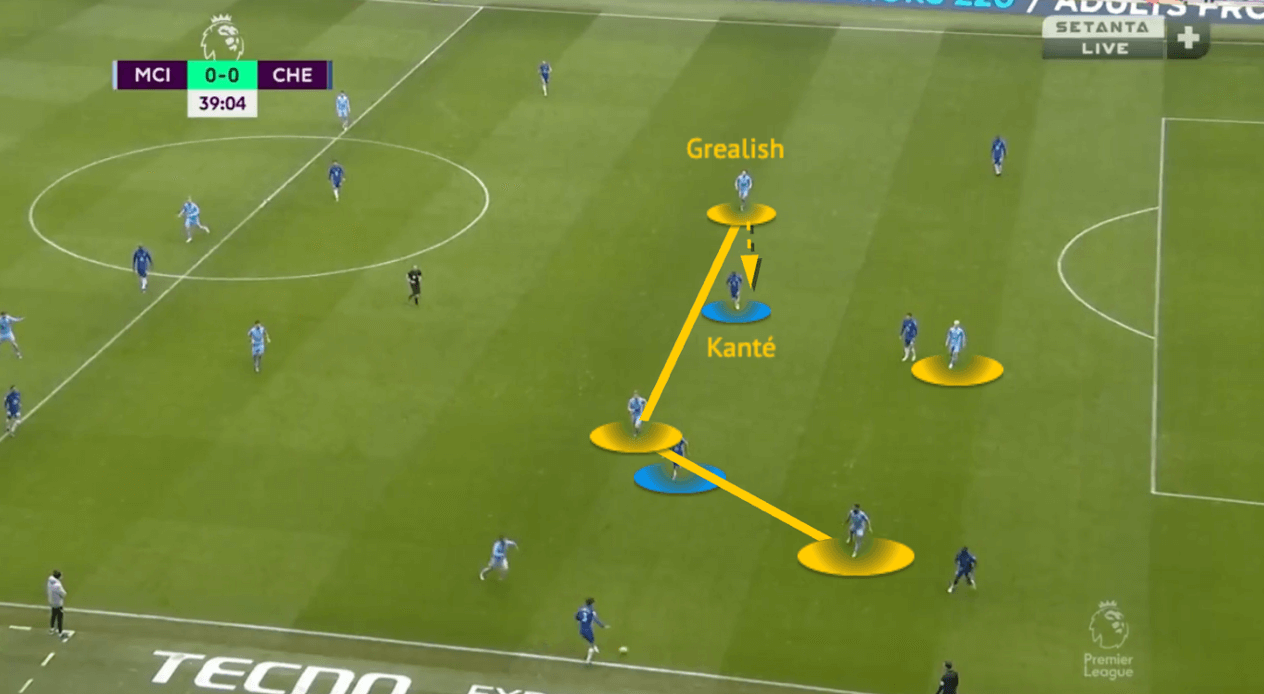
People always remembered how Grealish wasted a chance against Chelsea, but almost no one pointed out that was attributed to his great defensive work. It was out of the same concept we explained previously, against Chelsea’s 3-2 shape, the attack was on City’s right side.
Grealish did not switch off, instead, he was doing the work and realized he should keep an eye on the Chelsea midfielder, not the wide centre-back.
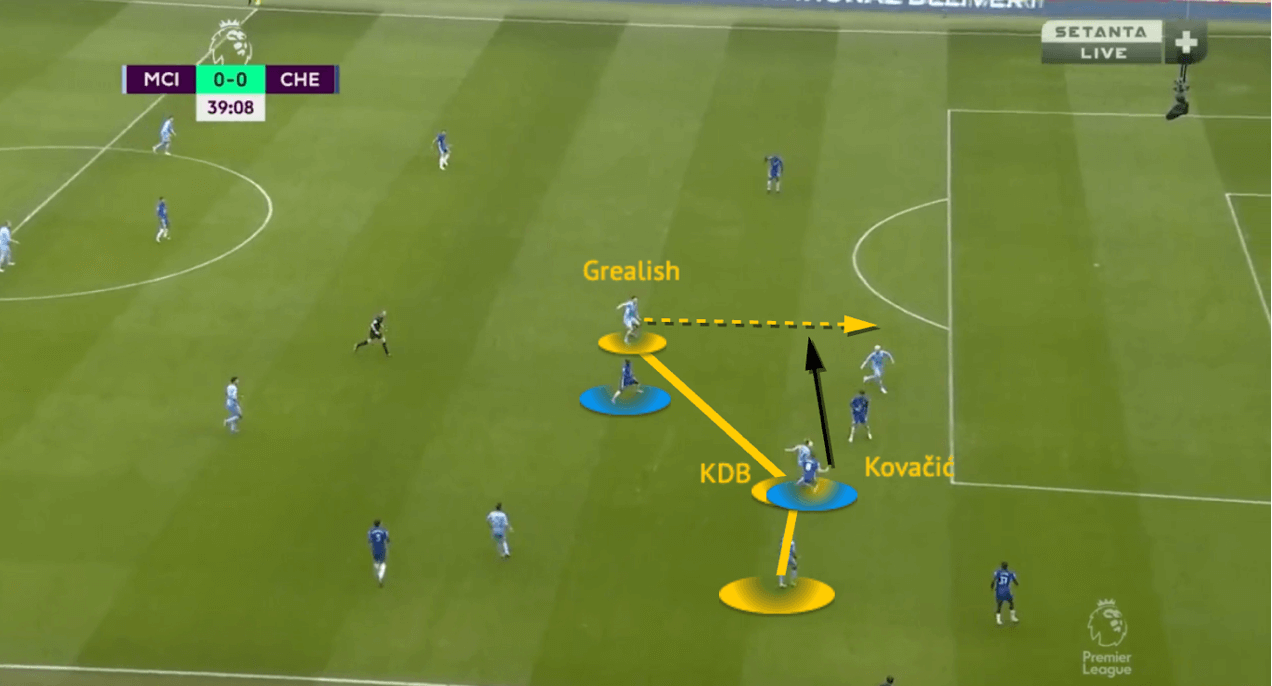
Then, Mateo Kovačić made a mistake by passing the ball inside, Grealish was in the right position to intercept – it was because his position is in the inside, he was ready to go for it. If he was staying on the wide left, the pass would made to the centre-back because Grealish would be too far too reach it.
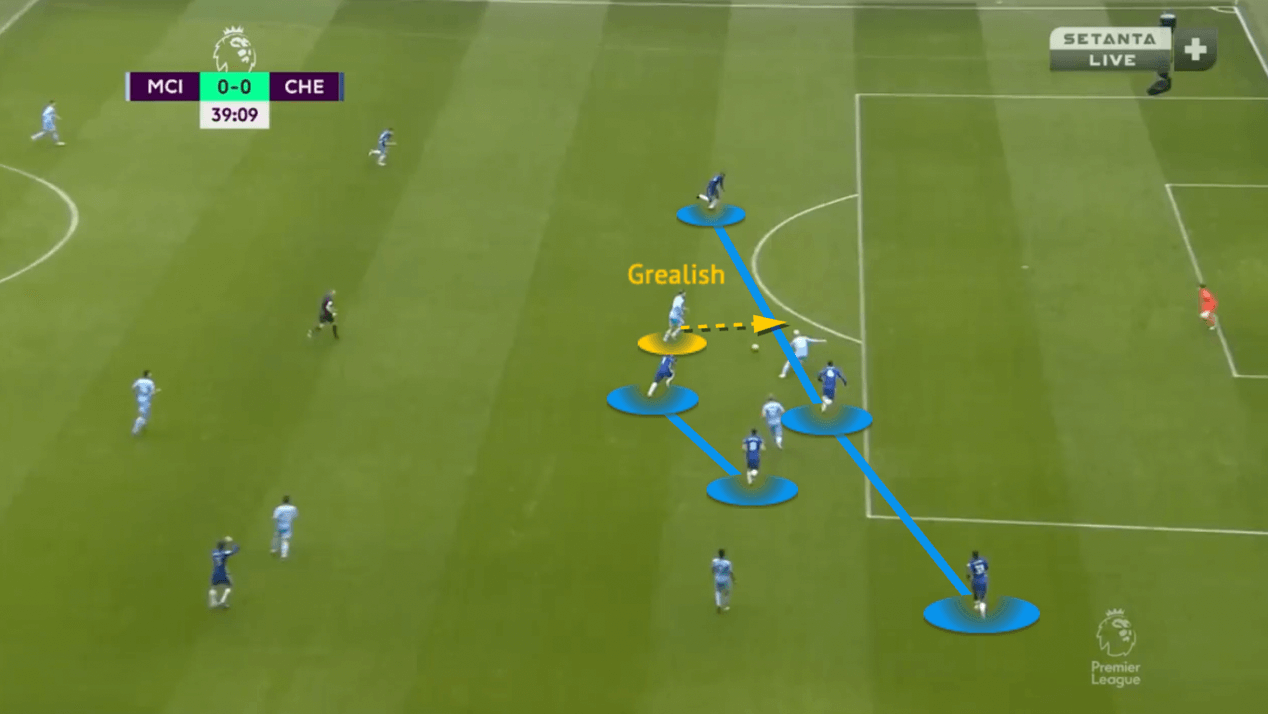
As a result, that became a goal-scoring chance and of course, Grealish should have scored it!
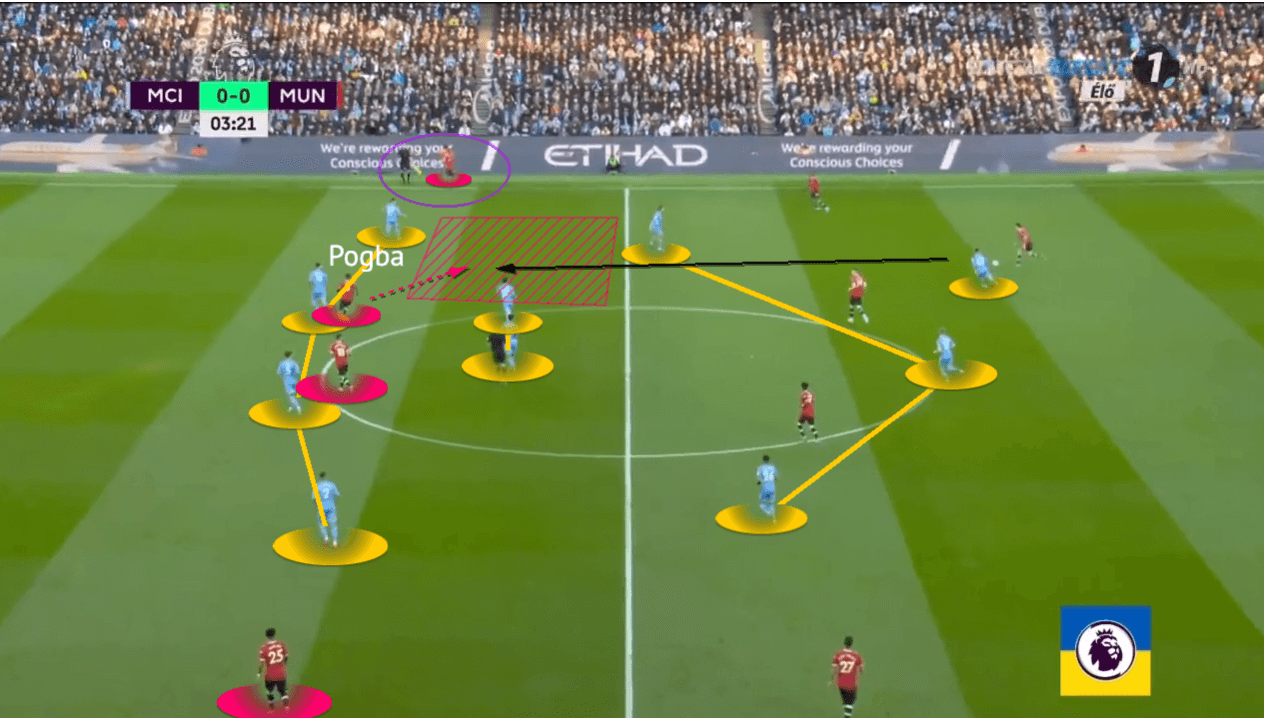
The last example against United shows how the good defensive work of Grealish, is not in the pressing, but more in a midblock shape. In the above image, many mediocre wingers would be attracted by the deep full-back of the opponent (Victor Lindelöf), stepping up in advance and wanting to press him. However, that was exactly what the opponent wanted, because then the red zone would be very exposed and there was a potential to attack in spaces behind the left.
But Grealish’s positioning was good, because he did not take out by Lindelöf, he stayed and kept adjusting with his tight footsteps, so when the ball came to Paul Pogba, City could apply pressure immediately without exposing spaces.
Conclusion
Through tactical analysis and the application of data, however, we found out that Grealish was not as bad as the people described. He could be better and be more clinical in front of the goal, of course, but City was not looking for a player who could only put the ball in the net. Instead, they needed an all-rounded profile who could help the team with special qualities, and Grealish was definitely the man they needed. Even Grealish himself admitted that he was transitioning from Villa to City, when he adapted and settled with the team, definitely he would shine like Mahrez and B. Silva, who also went through the same adaptation period when they first arrived in Manchester.





Comments